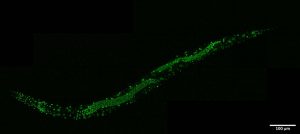Enter your address to receive notifications about new posts to your email.
Articles tagged Genetics Journal
(334 results)
-
New editors for Molecular Genetics of Development section of GENETICS
GENETICS is pleased to announce five new editors for the Molecular Genetics of Development section of the journal: Daniela Drummond-Barbosa, Chi-Chung Hui, Hamed Jafar-Nejad, Elliot Meyerowitz, and Karuna Sampath. Daniela Drummond-Barbosa Daniela Drummond-Barbosa is a Professor in the Department of Biochemistry and Molecular Biology at Johns Hopkins University. Her research focuses on the physiological mechanisms…
-
Yeast regain long-lost traits
Yeast circumvent Dollo’s Law and reacquire traits lost tens of millions of years ago from distant relatives. Dollo’s Law, first proposed in the 19th century, holds that evolutionary losses are irreversible — if a species discards a complex trait, it will never reacquire exactly that trait. However, a study published in Genetics highlighted one way that unicellular fungi can…
-
Welcoming new Gene Expression section editors to GENETICS
GENETICS is pleased to announce three new editors for the Gene Expression section of the journal: Julie Claycomb, Joseph Bondy-Denomy, and Geraldine Seydoux. Julie Claycomb Julie Claycomb holds a longstanding interest in gene regulatory mechanisms involved in germline development. She started her lab in the Dept. of Molecular Genetics, University of Toronto, in 2011. She…
-
Three GENETICS articles from 2020 recognized with Editors’ Choice Awards
Congratulations to the winners of the Editors’ Choice Awards for outstanding articles published in GENETICS in 2020! The journal’s Editorial Board considered a diverse range of articles, finding many papers worthy of recognition. After much deliberation, they settled on one exceptional article for each of the three award categories: molecular genetics, population and evolutionary genetics,…
-
Announcing new sections at GENETICS
GENETICS is pleased to announce the addition of new sections as part of a topical reorganization to best convey its scientific interests.
-
A look ahead with GENETICS Editor in Chief Howard Lipshitz
Stepping up to the helm of a journal like GENETICS is no easy task, but Howard Lipshitz is ready for the challenge. * GENETICS and GSA have been a part of Lipshitz’s career from the very start. “I joined the Society in 1979 as a student member so that I could get a monthly copy…
-
Nerve cell organelle mystery
NUN bodies in C. elegans offer clues about nervous system differentiation. One of the most active areas of research today explores the differences between individual cell types and how cells become differentiated. This specialization of cell types relies on changes in gene expression, but how those changes are orchestrated remains unknown. Now, research published in…
-
New Senior Editors joining GENETICS and G3
GENETICS and G3: Genes|Genomes|Genetics are pleased to announce two new Senior Editors: Meera Sundaram and Brian Oliver. GENETICS Meera Sundaram Meera Sundaram is a Professor of Genetics at the University of Pennsylvania Perelman School of Medicine. She received her BA in Biology from Mount Holyoke College and her PhD in Molecular Biology from Princeton University, and…
-
New editors are joining GENETICS
GENETICS is pleased to announce three new editors: Kavita Jain, Amanda Larracuente , and Tina Tootle. GENETICS Kavita Jain Kavita Jain is a theoretical physicist by training and has been working on problems in theoretical population genetics for more than a decade. She is interested in understanding the adaptive dynamics of microbial populations, evolutionary dynamics…
-
Announcing three new GENETICS editors
GENETICS is pleased to announce three new editors: Jonathan Flint, Michael Gore, and Aurélien Tellier. GENETICS Jonathan Flint David Geffen School of Medicine, UCLA Jonathan Flint is a British behavior geneticist and professor in residence in the Department of Psychiatry and Biobehavioral Sciences at the David Geffen School of Medicine at UCLA. In 2015, he…
-
Three new editors join GENETICS
GENETICS is pleased to announce three new editors: Barbara Conradt, Eva Hoffmann, and Jianming Yu. GENETICS Barbara Conradt University College London, UK Conradt studied in Germany and the US. For her PhD she joined Bill Wickner’s lab at UCLA where she worked on biochemical analyses of vacuole inheritance in S. cerevisiae. As a postdoc, she joined…






